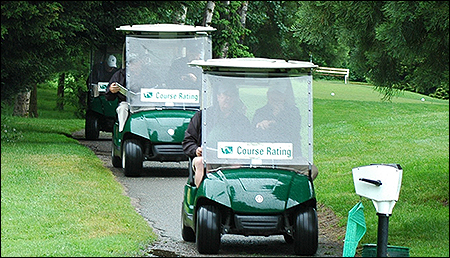by Kevin Jones, WSGA Manager of IT and GHIN Services
The USGA Course Rating System, which is now the leading rating system internationally, is complex and firmly rooted in mounds of research. Its ultimate goal, though, is to keep things as objective as possible when a Course Rating team makes a visit to a golf course.
The USGA Course Rating System is essential, actually required, for the USGA Handicap System to exist. Each cannot survive without the other. The data Course Raters collect out on the golf course and translate into that Course Rating and Slope provides the key component for any golfer to post a score and have it converted into a Handicap Index.
How that data is collected and transcribed is where Course Rating requires experience and a firm understanding of your surroundings when analyzing any golf hole. And this is where the “art” of Course Rating starts to come alive.
I am sure many of you have gone to an art gallery and stood in front of a painting and asked yourself, “What am I looking at and what does it mean?” And when you finally reach a conclusion, you might look to a friend and ask the same question about the same piece of art only to find out they were thinking the exact opposite.
We all see things differently and most of that comes from our own experiences in life, and much the same applies to Course Rating. The main difference here, though, is a Course Rater is forced to not only see their own perspective, but understand the mind-set of many others.
The USGA Course Rating System is made up of Scratch and Bogey players, Men and Women, and we must understand each and every one of them. That is why when a State or Regional Golf Association (SRGA) goes out to rate a course, we never do it alone.

There are many essential elements that go into rating a course, taking into consideration fairways, bunkers, water, etc., but how a Course Rater translates that to usable data requires a certain craft.
Most “newbie” raters will record items quite literally which are in front of them and go straight to the guide to get the value. While this works out in most cases, every situation is unique and might require a tweak here and there. The USGA Course Rating System Guide has a plethora of adjustments for when certain situations come up. These are applied accordingly, giving us the correct data for the overall rating, but here is when experience can really kick in.
The more and more you rate golf courses, you begin to see patterns in how certain situations should play out, which can be translated into a value of the overall rating. While every golf course is unique in its own right, sometimes past experience will tell you to make an adjustment even though it has no representation in the guide itself. This can be attributed to probability or maybe simply looking at the situation from a different viewpoint. Consider it a small stroke of the brush by a painter to fully capture the essence of the situation.
Seasoned Course Raters will spend years developing this skill, but over time this mindset comes naturally and, frankly, provides a unique dimension to our sport.
The USGA Course Rating System was designed so raters of all likes can come together to build a Rating and Slope which ultimately creates equity in our game. It is that collective experience and “stroke of the brush” that most sports do not have. If you ask any person about their experience with the game after doing a few course ratings, most will say they see golf in a whole new light. It is kind of a backstage pass to the true complexities of the game, while also giving them a say in how this course will be viewed by all who come and play it. Quite unique.
I would be remiss if I did not state that Course Rating is not for everyone. It takes time, study, and a deep understanding of how golf works in relation to its surrounding elements. Most Course Raters love doing it because it is fascinating and involves deep conversations with their fellow raters about how something will play out. When you collectively bring that all together, the rating will most likely be spot on.
While the USGA Course Rating System is primarily driven by constants (such as yardage) that cannot be changed, the collective perspective of many is what truly gives Course Rating its unique touch.
The next time you step onto the tee at a golf course, stand back as if you were at an art gallery and really take a look at everything that makes up that hole. This will give you a glimpse of a Course Rater’s mindset and appreciation for the hundreds of volunteers who SRGA’s depend on each year to deliver the most accurate information to each and every golfer. That is what I call a work of art!
If you are interested in knowing more about Course Rating, please contact us.
